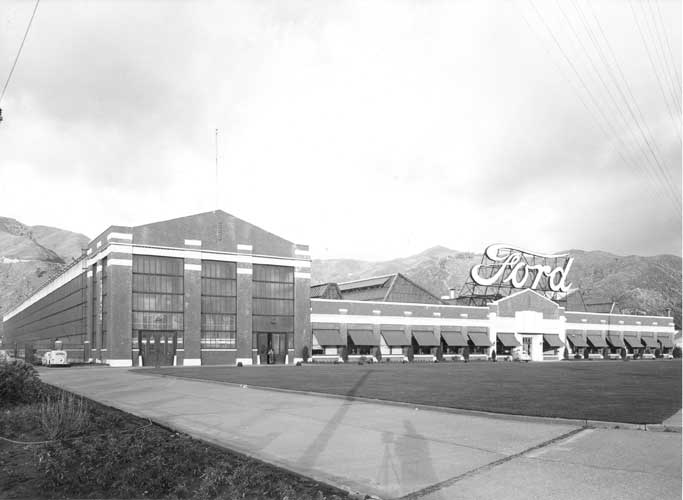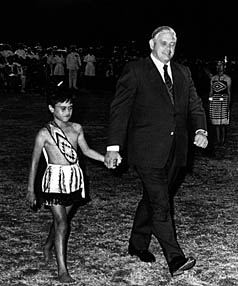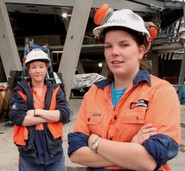Don Franks

Because he once stood against Tom Skinner for FoL president, Danny Nichols will always rate at least a footnote in bourgeois labour movement history.
Which is more than most other shop floor militants get, because so much of our working class history never makes the scholarly pages. But it’s a simple fact that to thousands of Hutt Valley workers, their Danny the Red is literally remembered as a central figure of the last century.
Dennis Allan Nichols came from a dirt poor London working class family to seek a better life in New Zealand. In the late 1960s he got a job at Ford’s Lower Hutt car plant and for a while just kicked back and enjoyed the job security, relatively good pay and nice climate. He had an easy operation in charge of the phosphate machine and like other class savvy British immigrants, he made a comfortable niche for himself in the softer kiwi job environment.
But as time went on, Danny began to register the various injustices visited on less clued up workers in the unorganised plant. In those days there was no active union on site and foremen could and did sometimes clip a worker over the ear if he or she didn’t jump to it fast enough. Danny started making a few waves and began to revive the then defunct Coach and Motor Body Workers Union . In the course of this Danny got talking to union officials in the pub. Two of those officials were Ken Douglas and Pat Kelly. Ken suggested that the new fledgling car plant activists be delivered up to the Engineers Union. Pat came down to the plant and helped develop the Coach Workers into a radical independent job organisation. The main ingredients were a number of inexperienced but militant Maori line workers and Danny’s extraordinary leadership. Continue reading “Danny the Red”
The Mana By-Election experiment
Note that this article does not necessarily represent the views of the whole party.
Don Franks

Below the big beaming blue and red billboards it was vacuous capitalist personality politics as usual.
Labour’s candidate claiming to be “working for Mana’ was Labour Party leader Phil Goff’s press secretary.
The best National’s Hekia Parata could produce for a slogan was a bastardisation of her own name – Vote Parata- “Heck yeah!”.
In the end Labour’s Kris Faafoi won the seat with 10,397 votes to Parata’s 9317.
National came within 1080 votes of snatching a safe Labour seat while their party is in government. Parata shattered Labour’s previous 6000-plus majority, turning Mana from the ninth safest seat in the country and one of Labour’s strongest bastions to a marginal one for the 2011 elections. Continue reading “The Mana By-Election experiment”
Why unions should not be affiliated to the NZ Labour Party
The Spark November 2010
This is a follow-up to the article in the last issue of The Spark where we welcomed the decision of the Victorian Electrical Trades Union to disaffiliate from the Australian Labour Party. This article looks at the problem of union affiliation to the NZ Labour Party; it is drawn mainly from our pamphlet, Labour: a bosses’ party.
Before the fourth Labour government, much of the blue-collar union movement was affiliated to the Labour Party. Since then however, very few unions have remained affiliated. The two main unions keeping the formal ties to Labour are the EPMU (Engineering, Printing, Manufacturing Union) and the SFWU (Service and Food Workers Union). In recent years, in particular since the collapse of the left social-democratic Alliance Party, several small unions (Rail and Maritime Transport, Dairy Workers and Maritime Union) have reaffiliated.

The main argument put forward by union leaders supporting affiliation is basically that it is better to be in the tent exerting influence on Labour policy than outside it simply opposing policy.
However, this argument is deeply flawed, as can be seen by looking at the actual history of union involvement in the Labour Party.
In 1918 there were 72 affiliated unions and just 11 party branches. In the 1919 general election, nine Labour candidates won seats, eight of them being active unionists. In 1938 three quarters of all union members were affiliated to the Labour Party; by 1971 it had fallen to just one half. Continue reading “Why unions should not be affiliated to the NZ Labour Party”
Showing the way forward:Australian union disaffiliates from Labor Party
The Spark October 2010
Philip Ferguson
In July this year, the Victorian branch of the Electrical Trades Union (ETU) took an important step forward and disaffiliated from the Australian Labor Party (ALP). Over 85% of those who took part in the vote voted to disaffiliate. Dean Mighell, the secretary of the Victorian union, told the paper Green Left Weekly, “Our members have watched over a long period of time as the ALP has attacked their union. . . They like the idea of their union being politically independent and putting their interest first and not the interests of any one party. We didn’t get any sense that members don’t want us campaigning on political issues that affect them. But they don’t see themselves as wedded naturally to the Labor Party.”
Affiliation hinders workers
Mighell noted the affect that being affiliated to the ALP has on unions campaigning for their members, saying, “What I’m bitterly disappointed about is that the union movement only seriously campaigns when the conservatives are in power. In reality, we’ve got conservatives in power now.” The union “looked at how we achieve political change for our members and what the most effective way was to do it”. They decided that they would be much more effective politically by ending their affiliation to Labor. Continue reading “Showing the way forward:Australian union disaffiliates from Labor Party”
A far left reply to Chris Trotter
– Don Franks, Workers Party candidate for Wellington Central 2008
The Dominion Post warns of a malicious workers’ enemy currently lurking in New Zealand.
What “it” supposedly “wants to see (on workers tables) are scraps of stale bread and cups of cold water.” Along with “the power and the phone cut off, holes in the roof, and the car up on blocks in the front yard.”
“Nothing delights it more than the sight of padlocked factory gates, and the sobbing of laid-off workers is music to its ears.”
According to Dominion Post columnist Chris Trotter, this inhumanity embodies none other than the revolutionary component of the political left. He specifically cites the Workers Party as an example.
According to Trotter:
“The more the National Party cuts back and hacks away at the workers’ economic and social rights the better the revolutionaries like it.
“The far Left is always at its unhappiest when Labour is in power. In no time at all they’ve got the power and the phone reconnected, filled up the fridge, got a bit of a fire going in the grate, slipped a couple of pizzas in the oven, and cracked open a few cool ones.” (From The Left, Dominion Post 12/12/2008)
Chris may have forgotten that it was under Labour that Mrs Folole Muliaga tragically lost her life when her power was cut off.
The 90-day bill – us and them
-Jared Phillips
Continuing with the New Zealand employers’ labour-flexibilisation drive, Prime Minister John Key has announced the introduction of a 90-day probationary employment bill that will allow new workers to be sacked without appeal, and it will come into force in March 2009.
What it means for workers
Those whose conditions will be directly attacked are the employees who are or will be in their first 90 days of employment at firms employing less than 20 people.
Slightly more than 30% of employees are employed in firms with less than 20 employees. The Council of Trade Unions has observed that of all employees, approximately 100,000 are in the first 90 days of employment, with a small employer, at any one time.
Solidarity to rebuild unions
-Daphna Whitmore
During the 1990s under the National government union membership fell by 50 percent. In 2000 just after Labour came in to office 69 percent of the public sector workers were covered by collective agreements and 21 percent of workers in private sector jobs.
Did that situation improve during nine years of “a worker-friendly government”, as the CTU leadership describe Labour?
Not at all. This year 59 percent of public sector workers have collective agreements, and a mere 10 percent of private sector workers.
The table below shows the grim reality.
And while the public sector collective agreement coverage declined, it is still significantly higher than the private sector.
A really serious trade union movement would look at assisting the private sector through subsidies from the much better off public sector. We need a union movement that takes the interests of the whole of the working class. That’s the sort of solidarity that would help build up unions in the private sector, which is where exploitation of the working class originates.
The reign of Helen Clark
– Daphna Whitmore
The Spark December 2008 – January 2009
The end was swift. Stepping down on election night Helen Clark ended 16 years as the Labour Party’s leader and nine years as Prime Minister. As Labour’s longest serving head, she was one of its most capable and helped shape the organisation into an urban liberal capitalist party.
Clark personified the new type of Labour politician. She came from a middle class farming background and was university educated. She studied politics and lectured for a few years at Auckland University, then headed straight to parliament in 1981.
In 1984 Labour won the elections and launched Rogernomics. There was not a peep of opposition to this rabidly neo-liberal programme from Clark. Later on she would try to distance herself from that period but as David Lange once quipped, Clark “was so dry she was combustible”. According to Michael Basset, who was a minister in that government, Clark begged Roger Douglas to return to the finance minister’s role in January 1990 when the party was rife with internal divisions over Rogernomics.
Silence of the Lambs
– Don Franks
Before the election, NZCTU President Helen Kelly had much to say about the two main parties. On April 13th she told the Labour Party Congress:
“Working people have been given the chance to get back on their feet with this government. This is not just because of good policies. It is because we have a Government made up of people who care about workers, who understand the difficulties they face, and who try to make things better.”
Kelly was not quite – absolutely obsequious in her praise of Labour, adding:
“Of course this does not mean that we live in paradise! There is more to do. And workers are really feeling the pinch at the moment with high food prices, rising petrol costs and high rents and mortgage payments.”
Then, even this mild admonition was hastily qualified into nothingness, with the soothing:
“So we need more change and with the continuation of a Labour led government we know that will happen. Labour is the Government with a proven record of change for the better and we need more of it.”
And, after the vision of heaven the warning of hell:
“We have seen National’s industrial relations policy and it is dramatic and will have a major negative impact on working people.”
“National’s plans for industrial relations are the same as in 1991”.
Just before I began writing this, I took a look at the NZ Council of Trade unions website, to see if there was any comment on the election result. Still, after two weeks, not a peep. As we supposedly teeter on the brink of another 1991! It would seem that if National’s plans for industrial relations are really the same as in 1991, so too are the plans of the CTU. Determined inertia. Remember when the top leaders refused to take up calls for a general strike to defeat National’s Employment Contracts Act?
If National is poised for launching a major negative impact on working people, wouldn’t it be the task of union leaders to start rallying and mobilising opposition from day one?
No illusions or delusions
The Workers Party has been rationally assessing the two main political parties for many years. This cartoon appeared with an article in The Spark February 2007 on the similarities between Labour and National.
Whereas a considerable section of the left had illusions in Labour and delusions about National, our analysis has proved to be sound.


